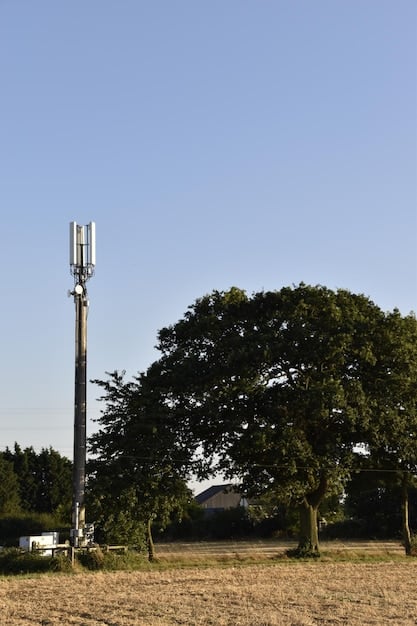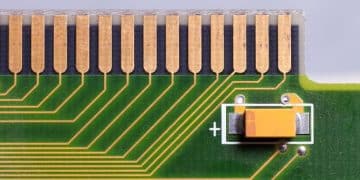Wireless Backhaul: How US Telecoms Expand 5G Coverage

Wireless backhaul plays a crucial role in expanding 5G coverage across the US, enabling telecoms to efficiently connect cell towers and transmit data, thus improving network performance and reach.
As the demand for faster and more reliable mobile internet grows, US telecoms are increasingly turning to wireless backhaul solutions to expand 5G coverage. But what exactly is wireless backhaul, and how is it being used to supercharge 5G networks across the United States?
Understanding Wireless Backhaul and Its Role in 5G Expansion
Wireless backhaul is a technology that connects cell towers to the core network without the need for physical cables. This is a vital element for expanding 5G coverage, which often requires dense infrastructure and flexible deployment options.
In the US, wireless backhaul is becoming increasingly popular because it offers a cost-effective and rapid alternative to traditional fiber optic connections. Let’s delve into how this technology supports 5G expansion.
Benefits of Wireless Backhaul
Wireless backhaul offers several key advantages that make it ideal for expanding 5G coverage in the US:
- Cost-Effectiveness: Unlike laying fiber optic cables, wireless backhaul solutions reduce the costs associated with digging, permits, and physical infrastructure.
- Rapid Deployment: Wireless solutions can be deployed much faster than fiber, allowing telecoms to quickly expand their 5G networks.
- Flexibility: Wireless backhaul is highly adaptable to various terrains and environments, making it suitable for both urban and rural areas.
Types of Wireless Backhaul Technologies
Several technologies fall under the umbrella of wireless backhaul, each with its own strengths and applications:
Microwave backhaul is one of the most commonly used technologies, providing high-capacity connections over long distances. Another emerging option is millimeter wave (mmWave) backhaul, which offers even higher bandwidth but is typically used for shorter distances due to signal attenuation. Free-space optics (FSO) is also used in specific situations.
In conclusion, wireless backhaul is a cornerstone of 5G expansion in the US, offering cost-effective, rapid, and flexible solutions for connecting cell towers to the core network.
How US Telecoms Are Leveraging Wireless Backhaul for 5G
US telecoms are strategically using wireless backhaul to overcome the challenges of deploying 5G networks. These challenges include high costs, deployment time, and geographical limitations. Wireless backhaul can tackle each of those challenges.
From rural deployments to urban densification, wireless backhaul is proving to be a valuable tool in the 5G arsenal.

Case Studies of Successful Deployments
Several US telecoms have successfully deployed wireless backhaul to expand their 5G coverage:
Verizon, for example, has used microwave backhaul to connect cell towers in rural areas where fiber optic connections are not economically feasible. T-Mobile has utilized mmWave backhaul to densify its urban 5G network, providing faster speeds and greater capacity. AT&T has also invested in wireless backhaul solutions to enhance its 5G offerings.
- Verizon: Enhanced rural connectivity using microwave backhaul.
- T-Mobile: Urban densification with mmWave backhaul.
- AT&T: Improved 5G performance through flexible wireless solutions.
Overcoming Deployment Challenges with Wireless
Wireless backhaul helps US telecoms overcome several key deployment challenges:
In rural areas, the cost of laying fiber can be prohibitive. Wireless backhaul offers a more affordable alternative, allowing telecoms to connect remote cell towers. In urban areas, wireless backhaul can be used to quickly densify networks, providing the capacity needed to support high 5G usage. Furthermore, wireless backhaul can also be used to bypass geographical obstacles such as rivers, mountains, and railways where laying fiber is difficult or impossible.
In conclusion, US telecoms are leveraging wireless backhaul in a variety of ways to expand their 5G coverage, from rural deployments to urban densification, overcoming the inherent challenges of deploying super fast 5G networks.
The Economic Benefits of Wireless Backhaul for 5G Expansion
The economic benefits of wireless backhaul extend beyond initial deployment costs. Wireless backhaul offers significant savings in terms of operational expenses and future scalability.
By reducing the need for expensive fiber optic connections, telecoms can allocate resources more efficiently and accelerate their 5G rollout.
Reducing Capital Expenditure (CAPEX)
One of the primary economic advantages of wireless backhaul is the reduction in capital expenditure (CAPEX):
Laying fiber optic cables involves significant upfront costs, including materials, labor, and permits. Wireless backhaul eliminates these costs, allowing telecoms to deploy 5G networks more quickly and affordably.
Lowering Operational Expenditure (OPEX)
Wireless backhaul also helps lower operational expenditure (OPEX) that telecoms would normally pay:
Fiber optic networks require ongoing maintenance and repairs. Wireless backhaul solutions typically have lower maintenance costs and faster repair times, reducing the overall operational burden. They also reduce the costs of energy consumption and physical security.
Ultimately, wireless backhaul can improve the overall profitability of 5G deployments, making it a financially attractive option for US telecoms.
The Future of Wireless Backhaul in the US 5G Landscape
The future of wireless backhaul in the US 5G landscape looks promising as technological advancements continue to improve its performance and capabilities. Innovations such as advanced antenna systems and improved signal processing are enabling wireless backhaul to deliver even higher bandwidth and greater reliability.
As 5G technology evolves, wireless backhaul will play an increasingly important role in supporting the next generation of mobile networks.

Emerging Technologies in Wireless Backhaul
Several emerging technologies are poised to transform wireless backhaul:
- Advanced Antenna Systems: Beamforming and massive MIMO technologies enhance signal strength and reduce interference.
- Improved Signal Processing: Advanced modulation and coding schemes increase bandwidth and improve reliability.
- Software-Defined Networking (SDN): SDN allows for dynamic allocation of network resources, optimizing performance and efficiency.
The Role of Wireless Backhaul in Rural 5G Expansion
Wireless backhaul is particularly crucial for expanding 5G coverage in rural areas:
Many rural areas lack the infrastructure needed to support fiber optic connections. Wireless backhaul offers a cost-effective and rapid alternative, enabling telecoms to bring 5G services to underserved communities and bridge the digital divide.
In conclusion, the future of wireless backhaul in the US 5G landscape is bright, with emerging technologies and ongoing innovations driving its adoption and expanding its capabilities to deliver enhanced connectivity and improved network performance.
Challenges and Considerations for Wireless Backhaul Deployment
While wireless backhaul offers numerous benefits, it also presents certain challenges and considerations that US telecoms must address. These include regulatory issues, signal interference, and security concerns.
By carefully planning and mitigating these challenges, telecoms can ensure the successful deployment of wireless backhaul solutions.
Regulatory and Licensing Issues
Regulatory and licensing issues can be a major hurdle for wireless backhaul deployments:
Telecoms must obtain the necessary licenses and permits to operate wireless backhaul systems. These regulations can vary by state and locality, creating a complex and time-consuming process. A pro-active approach is vital.
Mitigating Signal Interference
Signal interference is another common concern:
Wireless signals can be affected by a variety of factors, including weather conditions, physical obstructions, and interference from other devices. Proper planning and mitigation techniques are essential to ensure reliable performance. These include site surveys, spectrum analysis and the use of advanced interference-mitigation technologies.
In summary, while challenges exist in deployments, these can be addressed and wireless backhaul is still a very promising solution that is here to stay, and to increase in relevance in the future.
Best Practices for Optimizing Wireless Backhaul Performance
Optimizing wireless backhaul performance is crucial for ensuring reliable 5G connectivity. By following best practices in network design, equipment selection, and ongoing maintenance, US telecoms can maximize the efficiency and effectiveness of their wireless backhaul solutions.
This approach supports network performance and improves user experience.
Network Design and Planning
Careful network design and planning are essential for optimizing wireless backhaul performance:
- Site Surveys: Conduct thorough site surveys to identify potential obstacles and interference sources.
- Capacity Planning: Ensure that the backhaul network has sufficient capacity to support the expected 5G traffic.
- Redundancy Planning: Implement redundancy measures to protect against equipment failures and ensure network uptime.
Ongoing Monitoring and Maintenance
Regular monitoring and maintenance are vital for maintaining optimal wireless backhaul performance:
Continuously monitor network performance metrics to identify and address potential issues. Implement a proactive maintenance program to prevent equipment failures and ensure the continued reliability of the wireless backhaul network. Regular software updates and security patches should also be implemented.
With the right strategies in place, US telecoms can optimize their wireless backhaul performance and deliver a seamless 5G experience to their customers.
| Key Point | Brief Description |
|---|---|
| 🚀 Wireless Backhaul | Connects cell towers to the core network without physical cables. |
| 💰 Cost Savings | Reduces CAPEX and OPEX compared to fiber optic connections. |
| 📡 Technology Variety | Includes microwave, mmWave, and free-space optics. |
| 🌐 Rural Expansion | Enables 5G deployment in rural areas where fiber is not feasible. |
Frequently Asked Questions (FAQ)
▼
Wireless backhaul refers to using wireless technologies to connect cell towers to the core network, eliminating the need for physical cables. This facilitates faster and more flexible network deployments.
▼
Wireless backhaul reduces costs by eliminating the expenses associated with laying and maintaining fiber optic cables. This includes lower installation and operational costs.
▼
The main types include microwave backhaul, which provides long-distance connections, mmWave backhaul, offering high bandwidth over shorter distances, and free-space optics (FSO), used in specific scenarios.
▼
Challenges include regulatory issues and licensing to obtain, and mitigating signal interference. Addressing these through careful planning and advanced technologies is crucial for successful deployment.
▼
Optimizing wireless backhaul performance involves careful network design and planning and ongoing monitoring and maintenance. This includes site surveys, capacity planning, and regular checks.
Conclusion
In conclusion, wireless backhaul is revolutionizing how US telecoms expand 5G coverage, especially in rural and challenging areas. Offering cost savings, rapid deployment, and flexibility, it overcomes many of the traditional barriers to network expansion, paving the way for faster, more reliable connectivity across the nation.





